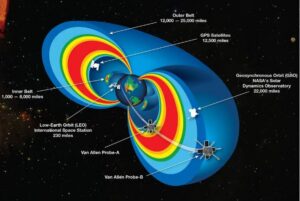Scientists from the University of Colorado Boulder have determined that lightning strikes in Earth’s atmosphere can release high-energy ‘killer electrons’ that are potentially deadly to humans. Sometimes called ‘hot electrons, ’ these potent particles not only pose a danger to astronauts but can also pass through metal to damage electronic components deep within orbiting satellites.
The Debrief recently reported on a team of scientists who determined that thunderstorms regularly generate gamma rays and even some antimatter. However, those same scientists said that, unlike these potentially deadly killer electrons, the amount of gamma-ray radiation exposure for someone flying through a thunderstorm is minimal and poses significantly less risk than turbulence or wind.
“These particles are the scary ones or what some people call ‘killer electrons,’” explained the study’s lead author, Max Feinland, who received his bachelor’s degree in aerospace engineering sciences at CU Boulder in spring 2024. “They can penetrate metal on satellites, hit circuit boards, and can be carcinogenic if they hit a person in space.”
Killer Electrons May Originate from Earth’s Radiation Belts
In their published research, the CU Boulder scientists note that the origin of the killer electrons released by lightning strikes is unknown. Still, they believe the likeliest culprits are the two radiation belts that encircle Earth “like an inner tube.”
Although the two belts, which consist of various high-energy particles, move over time, the team says that the “inner belt,” which is closest to Earth, can drop as low as six hundred miles above the planet’s surface. The second, “outer belt,” resides approximately 12,000 above Earth. Together, these radiation belts serve as a protective barrier between Earth’s life forms and the harsh, radioactive environment of space by absorbing most of the high-energy particles ejected by the Sun.


According to Lauren Blum, a co-author of the paper and assistant professor in the Laboratory for Atmospheric and Space Physics (LASP) at CU Boulder, scientists already knew that high energy particles like these killer electrons could sometimes leak out of the distant outer belt and make their way toward Earth. However, they didn’t know if or how these identical particles might be released from the inner belt to wreak havoc on orbiting electronics or human space travelers.
“Typically, the inner belt is thought to be kind of boring,” Blum said. “It’s stable. It’s always there.”
NASA Satellite Reveals Likely Role of Lighting in High Energy Particle Rain
Perhaps surprisingly, Blum says that the team’s discovery of the role lighting might play in the release of these killer electrons happened “almost” by accident when Feinland was reviewing data collected by the Solar, Anomalous, and Magnetospheric Particle Explorer (SAMPEX) satellite. Mixed within the data collected by SAMPEX, a NASA property that was already de-commissioned, were what Feinland described as “clumps” of these high-energy electrons zipping through the inner radiation belt.
“I showed Lauren some of my events, and she said, ‘That’s not where these are supposed to be,’” Feinland recalled. “Some literature suggests that there aren’t any high-energy electrons in the inner belt at all.”
After returning to the raw data, Feinland and the team identified 45 distinct surges of high-energy killer electrons captured by SAMPEX between 1996 and 2006. When these events were compared against recorded lightning strikes in North America, a number of them appeared to occur less than a second after a recorded lightning strike.
Researchers Suspect Lightning Strikes Kick Off Electron ‘Pinball’ in Space
In the study’s conclusion, the team postulates that the lightning strikes on the ground may be kicking off a game of electron “pinball” in the radiation belts.
For example, radio waves are blasted from Earth and into the inner radiation belt after a lightning strike. This causes some hot electrons trapped in the inner belt to ping around like a metal ball in a pinball machine. These particles move so fast that they ping between the planet’s northern and southern hemispheres in roughly 0.2 seconds.
“You have a big blob of electrons that bounces and then returns and bounces again,” Blum said. “You’ll see this initial signal, and it will decay away.”
The team believes that decay represents the killer electrons raining down on Earth’s atmosphere. If they are correct, that means this light-speed interaction between radio waves and high-energy particles is causing the detection of high-energy killer electrons in the SAMPEX data.
Blum says that more research will be needed to determine why this happens after some lightning strikes but not others. However, she suspects there may be a correlation between periods of high solar activity that effectively “stock” the radiation bets with a surplus of killer electrons and the lighting strikes that release them into Earth’s atmosphere.
In theory, the ability to predict these types of events could offer an additional layer of protection for astronauts against killer electrons and satellite operators looking to protect their space assets. But whatever the cause, the researchers say that their study shows there is almost certainly a connection between weather on Earth and in space that needs to be accounted for in future crewed or uncrewed missions.
“Space weather is really driven both from above and below,” Blum said.
The study, “Lightning-induced relativistic electron precipitation from the inner radiation belt” was published in Nature Communications.
Christopher Plain is a Science Fiction and Fantasy novelist and Head Science Writer at The Debrief. Follow and connect with him on X, learn about his books at plainfiction.com, or email him directly at christopher@thedebrief.org.

